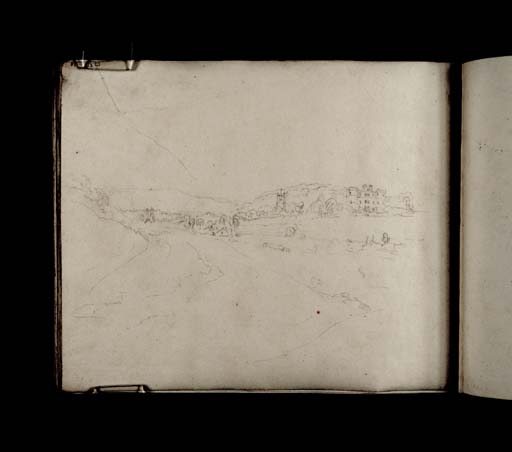Joseph Mallord William Turner Lulworth Castle and East Lulworth 1811
Image 1 of 2
Joseph Mallord William Turner,
Lulworth Castle and East Lulworth
1811
Joseph Mallord William Turner 1775–1851
Folio 19 Recto:
Lulworth Castle and East Lulworth 1811
D08828
Turner Bequest CXXIV 19
Turner Bequest CXXIV 19
Pencil on white wove paper, 170 x 209 mm
Blind-stamped with Turner Bequest monogram bottom centre
Stamped in black ‘CXXIV – 19’ top left, upside down
Blind-stamped with Turner Bequest monogram bottom centre
Stamped in black ‘CXXIV – 19’ top left, upside down
Accepted by the nation as part of the Turner Bequest 1856
References
1909
A.J. Finberg, A Complete Inventory of the Drawings of the Turner Bequest, London 1909, vol.I, p.354, CXXIV 19, as ‘Lulworth Castle’.
1979
Andrew Wilton, J.M.W. Turner: His Life and Work, Fribourg 1979, p.353 under no.467.
1981
Eric Shanes, Turner’s Rivers, Harbours and Coasts, London 1981, p.152.
1982
Louis Hawes, Presences of Nature: British Landscape 1780–1830, exhibition catalogue, Yale Center for British Art, New Haven 1982, p.175 under no.IV.32.
1992
Howard J.M. Hanley, Turner in Dorset: Images from the Picturesque Views on the Southern Coast of England, exhibition catalogue, Mulberry Gallery, Weymouth Library 1992, p.25 no.30, reproduced.
1997
Eric Shanes, Turner’s Watercolour Explorations 1810–1842, exhibition catalogue, Tate Gallery, London 1997, p.54 under nos.32 and 33.
Turner drew the seventeenth-century Lulworth Castle (later damaged by fire and now restored) and St Andrew’s Church, East Lulworth from the road to the east, probably on first approaching from the direction of Corfe Castle (for views of which see the entry for 17 recto; D08826).1 The Dorset castle and church are about a mile inland, and two miles from West Lulworth and Lulworth Cove, seen on folios 20 recto, 20 verso, 21 recto, 21 verso and 22 recto (D08829–D08833).
Eric Shanes has discussed Turner’s interest in the site in terms of the Catholicism of Thomas Weld, the owner of the castle and Lulworth Cove, to whom he had already dedicated an engraving.2 Presumably as in preparation for his West Country tour, Turner had noted in the Vale of Heathfield sketchbook: ‘Lulworth Castle built about 1600 seat of Thos Weld. entertained their Majesties’ (Tate D10206; Turner Bequest CXXXVII 1). These notes were taken from an approving passage in John Feltham’s Guide to All the Watering and Sea-Bathing Places (revised edition, London 1810, p.461) which also mentions ‘a beautiful expanse of water, and a moving scene of ships’ to be seen from the castle, and a ‘beautiful chapel’. This prominent Baroque, domed building stands in the grounds about the same distance to the north of the castle as the Anglican village church is to the south,3 but Turner made no visual record of the chapel or the coast immediately to the south.
As Finberg noted, this sole sketch of East Lulworth formed the basis of Turner’s watercolour Lulworth Castle, Dorsetshire of about 1820 (Yale Centre for British Art, New Haven),4 engraved in 1821 for Picturesque Views on the Southern Coast of England5 (see the concordance of the series in the 1811 tour introduction). Although the subject is not the ‘only completely inland scene’6 in the series (Corfe Castle being another), its relevance to the theme is perhaps debatable. In the watercolour, Turner exaggerated the height of the hill beyond the castle and church and introduced trees, a pool, cows and figures into the left foreground. There is also a colour beginning (Tate D36118; Turner Bequest CCCLXIV a 271), apparently showing morning light rather than the late afternoon sun of the finished design.7
For the castle and chapel see Lulworth, Dorset, accessed 9 October 2008, http://www.lulworth.com/Castle_Park/castle_park.htm .
Technical notes:
Tears and losses towards the top left corner have been repaired. The tear disrupts the stamped Finberg number, suggesting that it was repaired at a later date.
Verso:
Blank, save for inscriptions by John Ruskin in red ink ‘30’ top right and ‘647’ bottom left.
Matthew Imms
February 2011
How to cite
Matthew Imms, ‘Lulworth Castle and East Lulworth 1811 by Joseph Mallord William Turner’, catalogue entry, February 2011, in David Blayney Brown (ed.), J.M.W. Turner: Sketchbooks, Drawings and Watercolours, Tate Research Publication, December 2012, https://www


